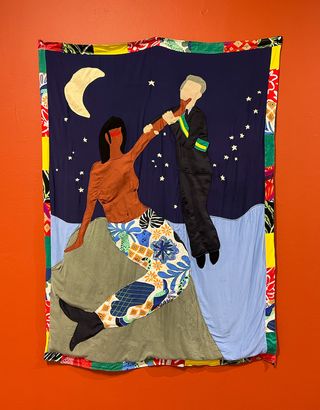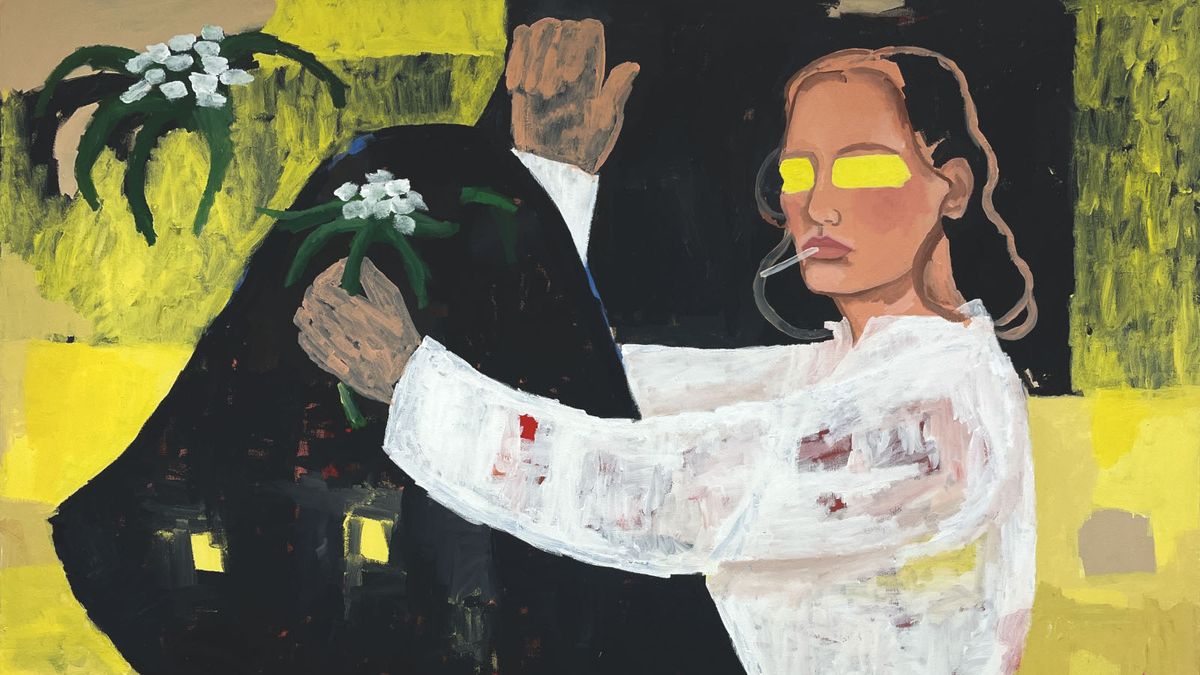‘Personal Structures’ is on a bold mission. Embracing the theme ‘Beyond Boundaries’ for its seventh edition, and adopting a fluid curatorial approach, this biennial exhibition of contemporary art aims to foster diverse perspectives and contradictions, serving as a lens to contemplate the intricate narratives within our global community.
Staged at the historic Venetian palazzos Bembo and Mora, within the gorgeous Marinaressa Gardens, and running alongside but independent of the Venice Biennale 2024, ‘Personal Structures 2024’ showcases the work of more than 200 contributors, selected from 51 countries: included are artists at various career stages – from painters and sculptors to multimedia artists, photographers and performers – alongside art and academic institutions and galleries. Collectively they reveal a rich tapestry of perspectives on the pressing challenges of our time – from culture and gender identity to politics, existence and climate urgency.

Marina Stamato, The Purge of Denialism – Mãe Iara defeats Bolsonaro, 2023
(Image credit: Courtesy of the University of Southern California)
‘Personal Structures’ was founded in 2002 by the artist René Rietmeyer as an independent project – an open platform of sorts for artists to exhibit and publish their work and thoughts. It started life initially as a reaction to non-subjective art, arguing instead that all artworks are made intrinsically with a part of the artist’s consciousness, and are thus personal. And it is this belief that remains pivotal to the organisation and all its exhibitions.
Critically, ‘Personal Structures’ gives a voice to the voiceless, underrepresented communities often overlooked by the Venice Biennale. And it refrains from being too didactic, allowing individual artistic circles curational autonomy to speak more fluidly individually, as a group and in response to Venice and its history.
We caught up with Sara Danieli, head of art at European Cultural Centre, the organisation that runs the exhibition, to gain more insight into ‘Personal Structures’.
‘Personal Structures’: art as dialogue, exchange and freedom
Sandra Cattaneo Adorno, Ten Years VI, 2023
(Image credit: ©Sandra Cattaneo Adorno, from Sandra Cattaneo Adorno/ Ten Years)
Wallpaper*: Art can be a powerful tool for storytelling, yet often the tendency with group shows is to be too didactic. How do you balance a vast exhibition like ‘Personal Structures’ to allow the artist to speak freely and, in the process, initiate unexpected narrative layers?
Sara Danieli: An appropriate context is necessary to trigger a better conversation, yet the dialogue needs to be as authentic and as sincere as possible to avoid becoming a dialogue for its own sake. It’s important that our artists have as much freedom as possible in expressing what’s most urgent for them, as a response to contemporary society, as well as reflecting on the human condition.
Miles Greenberg, FI 08-20-10, 2024
(Image credit: Courtesy of Galerie Breyer. ©Michael Jurtin)
W*: Would you say this is fundamental to the ‘Personal Structures’ project?
SD: Yes, our main concept is to consider each artwork within the artist’s experience, influenced by the time and space in which they live and work. Our title ‘Personal Structures’ was chosen in response to the 1966 exhibition ‘Primary Structures’ by minimalist artists such as Donald Judd and Carl Andre, who claimed to create non-subjective art, art without the ‘touch’ of the artist – the non-personal.
We believe even the most minimalist works are subjective, personal, the result of the artist’s own conditions and circumstances. We conceive the ‘Personal Structures’ exhibition as a platform that values the diversity of artistic approaches and expressions, with the intention of documenting plurality.
Areez Katki, Pedagogical Drawing 6 (HA 33), 2024
(Image credit: Courtesy of Areez Katki and Tarq Gallery)
W*: So, you’re saying a plurality of narratives comes naturally when you don’t dictate what is exhibited, nor the curational path. How involved are you in the artist selection and curational process?
SD: The exhibition organisation spans two years, during which conversations with artists commence at the planning phase and we continue to guide them through the entire process. The choice of space is also made with the artist, sometimes based on the project or their attraction to a specific location. Some artworks are exhibited alongside the work of other artists, and based on the nature, technical, formal, and conceptual needs of the artwork, we create a dialogue with the space and other projects.
Elizabeth Heyert, THE TRAVELERS, Daphne Jones Born 1954, Died 2003, 2003
(Image credit: Courtesy the artist)
W*: You deliberately moved away from the Venice Biennale a while ago. Do you feel the independence allows you to approach such a group exhibition with a much more open mind?
SD: Not being part of a governmental institution allows for choices that are not strictly political, thus moving away from such boundaries. This doesn’t mean that we don’t make choices, but there is certainly more freedom.
Samia Halaby, Massacre of the Innocents/Gaza, 2024, part of the Palestine Museum US’ exhibition ‘Foreigners in their Homeland’
(Image credit: Courtesy of the artist and the Palestine Museum US)
W*: There are plenty of powerful, moving exhibits throughout the show. Can you name a few that particularly speak to you and the overarching theme ‘Beyond Boundaries’?
SD: It’s been important to present the project by the Palestine Museum US, directed by Faisal Saleh. Particularly moving is presenting the drawings of the artist Maisara Baroud, who is currently in Gaza. He sent scans of his work from his phone, and we printed them on translucent material, hanging them in front of the window like a wall through which light passes as a way of symbolising hope.
Damian Le Bas, Back to the Future! Safe European Home 1938. Artists of Romany background from across Europe step out of invisibility at Palazzo Bembo in the site-specific exhibition ‘Roma Lepanto’, curated by Moritz Pankok and Miguel Angel Vargas Rubio
(Image credit: Courtesy of Foundation Kai Dikhas & Estate Damian Le Bas. ©Diego Castellano Cano)
Another significant project is ‘Roma Lepanto’, since it presents art as a catalyst for change, advocating for a permanent home for Roma art at the Venice Biennale, a demand that is still unmet. Artists of Romany background from across Europe emerge from invisibility, are given a platform to address the long history of Roma slavery and to confront the feelings of inferiority resulting from silenced history. By offering new perspectives on European events, Roma artists reclaim control of their narrative and present a self-image that showcases their talent, ideas, and positive contributions to society.
W*: What else can you highlight from the show?
SD: The group exhibition ‘Unapologetic WomXn’, which presents the work of 31 female artists exploring female sexuality through their own perspectives. Creating a safe community space, the exhibition humanises the subjects the artists focus on – their bodies, experiences, and how women navigate a constantly changing world – emphasising the importance of art and artists breaking free from societal constraints.
Faiza Butt, Phantasmagoric 4, 2023. The artist depicts contemporary society and its contradictions, stemming from an exploration of both private and public spheres
(Image credit: Courtesy of Marina Diaz Jimenez)
Another is a project presented by Faiza Butt, an artist with Pakistani roots and living in London, which draws from the Menagerie tradition of the Dutch Golden Age to depict contemporary society and its contradictions, stemming from her exploration of both private and public spheres. While Butt’s work portrays beautiful landscapes and animals, as well as her children, it is imbued with disturbing elements characteristic of contemporary society and the tragedies we face – war, hyper-consumerism and environmental pollution.
Emily Young, Lost Mountain Head I, 2013. Young’s series of sculptures dotted around Marinaressa Gardens and Palazzo Mora were created with stones found in abandoned quarries, stone yards and in the wild as a note on climate
(Image credit: Courtesy the artist)
W*: What do you ultimately hope viewers and visitors will take from the exhibition?
SD: We hope audiences will take away a renewed sense of possibility and empowerment. By reflecting on the theme of ‘Beyond Boundaries’, we aim to inspire individuals to recognise their capacity to overcome challenges and limitations, both personally and collectively.
Through the diverse perspectives and contradictions presented in the exhibition, we encourage viewers to embrace complexity, question preconceptions, and foster a deeper understanding of the human condition and society as a whole.
‘Personal Structures: Beyond Boundaries’ is at Palazzo Bembo, Palazzo Mora, and Marinaressa Gardens in Venice until 24 November 2024, personalstructures.com

